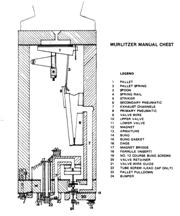

|
Pittsburgh Area Theatre Organ Society, Inc. |

|
THE THEATRE PIPE ORGAN
Just about everyone of this generation knows what a Pipe Organ is because at one time or other they have heard one in some Church. But the theatre organ, though similar in its working qualities, differs in some very significant ways. Obviously it is called a “Theatre Organ” because of its installation in virtually every movie house, large or small, during the 1920s and 1930s. Because of its unique capability over the classical church organ thanks to a genius English engineer Robert Hope-Jones, it replaced the piano, church organ, and eventually full symphonic orchestras to accompany the Silent Motion Picture. Large ornate Movie Palaces were built all over the country and featured a variety of Organ makes, of which Wurlitzer had prominence. The silent movies required all sorts of background music, and sound effects, which added to the enjoyment of what was seen on the screen. Mr. Hope-Jones is responsible for developing the electro-pneumatic action enabling the organist to get quicker precision response; designed the horse-shoe console with tongue-like stop tabs for ease of use; and most importantly invented the unified system of registrations making it possible to play any rank from any manual and/or pedal. These aspects differ significantly from the classical organ. This development created what was referred to as “The Unit Orchestra” because an accomplished player could create sounds from the softest flute, to a crescendo competing with a full symphony orchestra, Military Marching Band and making it the Grandest and most Spectacular Instrument ever devised by man!
Sketch of the WurliTzer chest action
Click Here for larger view and explanation
THE MUSICAL CAPABILITIES OF THE MIGHTY WURLITZER
As mentioned, the Hope-Jones inventions and modification of the classical church organ, resulted in the ability to create a staggering amount of tonal combinations combined with varying degrees of tremulation and special effects, for an emotional impact on the listener impossible to achieve in any other way. There is no music incapable of being rendered on this instrument when the various artists engaged by PATOS for our concerts are at the console.
The accomplished organist can play full orchestral or band arrangements of both classical and contemporary compositions with an awesome display of virtuosity. Such exciting selections like the 1812 Overture, The William Tell overture, Gershwin’s Rhapsody in Blue, Sousa Marches, Glen Miller’s great Band numbers...all these sounding as if the orchestra or band was on stage instead of one person.
The Unit Orchestra (now known as the Theatre Organ) is orchestral in the sense that many of the organ pipe ranks were designed to duplicate instruments common to bands and orchestras - and reasonably close in tonal textures, such as: Strings--violin, viola, etc.; brass (reed family) such as trumpet, tuba, post horn, saxophone, etc.; and the flutes all at various pitches. But in addition, unique stops such as Tibias, Diaphone, Kinura, Krumet, etc. all blended to create a rich palette of gorgeous sounds. Ah, but the Theatre Organ does not neglect the inclusion of the Diapason Rank (the foundation of the classical church organ) so that with the flip of stop tab switch, you can render a performance of Liturgical music such as Bach's Chorales, Masses, as well as his exciting Toccata and Fugues, etc. to Lloyd=s Phantom of the Opera quite effectively!
SUPERLATIVES
In its heyday, the Mighty Theatre Organ was referred to as “The Grand Organ” when advertised by the Theatre Palaces (also referred to as Movie Cathedrals). Adjectives describing this instrument beginning with Grand, are Mighty, Glorious, Spectacular, Exciting and Awesome. So these Web Pages have in mind the responsibility of introducing this instrument to the Post War “baby boomers” who for the most part, grew-up with the twang of the amplified guitar, very loud percussion beats, a cacophony of non-melodic and non-harmonic music. This same generation took to the technology of Tone Modules, Synthesis and MIDI setups spectacular in its own right. But the Theatre organ in fact was a precursor of the MIDI system, by virtue of being able to operate actual instruments from the console, such as acoustical and electronic pianos, marimbas, xylophones, bells, cathedral chimes, fog horns, animals, thunder and storms, auto horns and much more. PATOS and other Societies such as ours are dedicated to getting younger people involved in enjoying, appreciating and learning to play the Mighty WurliTzer (or any other Theatre Organ) and join us in preserving these Glorious instruments.
To watch a short cartoon-like video presentation created by the University of Bradford in the U.K. about organs, click HERE.
|
|
Technical Discussion |
